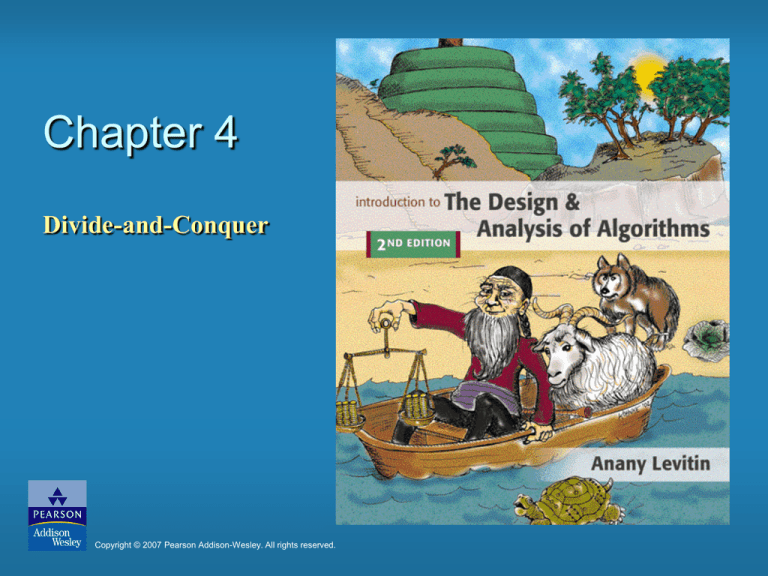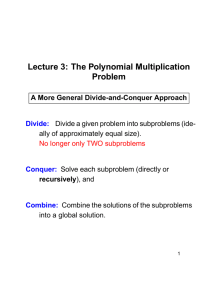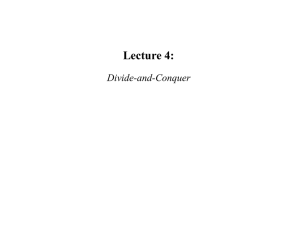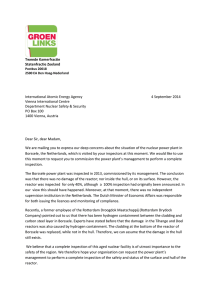
Chapter 4
Divide-and-Conquer
Copyright © 2007 Pearson Addison-Wesley. All rights reserved.
Tromino puzzle
Exercise 4.1.11. A tromino is an L-shape tile formed by 1by-1 adjacent squares. The problem is to cover any 2n-by-2n
chessboard with one missing square (anywhere on the
board) with trominos. Trominos should cover all the
squares except the missing one with on overlaps
Design a divide-and-conquer algorithm for this problem
Divide-and-Conquer
The most-well known algorithm design strategy:
1.
2.
3.
Divide instance of problem into two or more smaller
instances
Solve smaller instances (recursively)
Obtain solution to original (larger) instance by combining
these solutions
Pergunta: sempre melhor que força bruta?
contra-exemplo?
Divide-and-Conquer Technique (cont.)
a problem of size n
subproblem 1
of size n/2
subproblem 2
of size n/2
a solution to
subproblem 1
a solution to
subproblem 2
a solution to
the original problem
Como ficaria o uso em computadores paralelos?
Divide-and-Conquer Examples
Sorting: mergesort and quicksort
Binary tree traversals
Binary search (?)
Multiplication of large integers
Matrix multiplication: Strassen’s algorithm
Closest-pair and convex-hull algorithms
Casos: divisão por 2 e geral
Caso típico: divide por 2
Caso geral:
• Instância de tamanho n é dividida em b instâncias de tamanho b/n
das quais a devem ser resolvidas (a e b constantes, a>=1; b>1)
• Assumindo que n é potência de b (para simplificar análise) temos
T(n) = a T (n/b) + f(n)
• Onde f(n) responde pelo tempo que se leva para dividir o problema
em menores e/ou para combinar as soluções
• Ex: somar série com Divide and Conquer …
General Divide-and-Conquer Recurrence
T(n) = aT(n/b) + f (n) where f(n) (nd), d 0
Master Theorem: If a < bd, T(n) (nd)
If a = bd, T(n) (nd log n)
If a > bd,
T(n) (nlog b a )
Note: The same results hold with O instead of
Examples: T(n) = 4T(n/2) + n T(n) ?
T(n) = 4T(n/2) + n2 T(n) ?
T(n) = 4T(n/2) + n3 T(n) ?
Ver Apêndice B para prova do teorema
General Divide-and-Conquer Recurrence
T(n) = aT(n/b) + f (n) where f(n) (nd), d 0
Master Theorem: If a < bd, T(n) (nd)
If a = bd, T(n) (nd log n)
If a > bd,
Examples:
T(n) = 2T(n/2) + 1
T(n) = 2T(n/2) + n
T(n) = 2T(n/2) + n2
T(n) = 2T(n/2) + n3
T(n) ?
T(n) ?
T(n) ?
T(n) ?
T(n) (nlog b a )
(a=2, b=2, f(n)=1, d=0)
(a=2, b=2, f(n)=n, d=1)
(a=2, b=2, f(n)=n2 , d =2)
(a=2, b=2, f(n)=n3 , d=3)
General Divide-and-Conquer Recurrence
T(n) = aT(n/b) + f (n) where f(n) (nd), d 0
Master Theorem: If a < bd, T(n) (nd)
If a = bd, T(n) (nd log n)
If a > bd,
Examples:
T(n) = 2T(n/2) + 1
T(n) = 2T(n/2) + n
T(n) = 2T(n/2) + n2
T(n) = 2T(n/2) + n3
T(n) ?
T(n) ?
T(n) ?
T(n) ?
T(n) (nlog b a )
(a=2, b=2, f(n)=1, d=0)
n
(a=2, b=2, f(n)=n, d=1)
n log n
(a=2, b=2, f(n)=n2 , d =2) n2
(a=2, b=2, f(n)=n3 , d=3) n3
Mergesort
Split array A[0..n-1] in two about equal halves and make
copies of each half in arrays B and C
Sort arrays B and C recursively
Merge sorted arrays B and C into array A as follows:
• Repeat the following until no elements remain in one of
the arrays (total de n elementos):
– compare the first elements in the remaining
unprocessed portions of the arrays
– copy the smaller of the two into A, while
incrementing the index indicating the unprocessed
portion of that array
• Once all elements in one of the arrays are processed,
copy the remaining unprocessed elements from the other
array into A.
Pseudocode of Mergesort
Pseudocode of Merge
Mergesort Example
8 3 2 9 7 1 5 4
8 3 2 9
8 3
8
7 1 5 4
2 9
3
2
3 8
71
9
2 9
7
5 4
1
5
1 7
2 3 8 9
4 5
1 4 5 7
1 2 3 4 5 7 8 9
4
Analysis of Mergesort
All cases have same efficiency: Θ(n log n)
Number of comparisons in the worst case is close to
theoretical minimum for comparison-based sorting:
log2 n! ≈ n log2 n - 1.44n
Space requirement: Θ(n) (not in-place)
Can be implemented without recursion (bottom-up)
Estável ???
Quicksort
Select a pivot (partitioning element) – here, the first element
Rearrange the list so that all the elements in the first s
positions are smaller than or equal to the pivot and all the
elements in the remaining n-s positions are larger than or
equal to the pivot (see next slide for an algorithm)
p
A[i]p
A[i]p
Exchange the pivot with the last element in the first (i.e., )
subarray — the pivot is now in its final position
Sort the two subarrays recursively
Partitioning Algorithm
<=
Quicksort Examples
5 3 1 9 8 2 4 7
3 4 5 6 7
Estável ???
Analysis of Quicksort
Best case: split in the middle — Θ(n log n)
• n+1 comparações se indices cruzam, n se coincidem
• Cbest(n) = 2 Cbest(n/2) +n p/ n>1, Cbest(1)=0 (Master Theorem)
Worst case: sorted array! — Θ(n2)
• Cworst(n) = (n+1) + n + … + 3 = (n+1)(n+2)/2 – 3
Average case: random arrays — Θ(n log n)
•
Cavg(n) = 1/n ∑s=0
n=1
[(n+1) + Cavg(s) + Cavg(n-1-s)] p/ n>1, Cavg(0)=0, Cavg(1)=0
Improvements (combine to 20-25% ):
• better pivot selection: median of three partitioning
• switch to insertion sort on small subfiles
• elimination of recursion
Considered the method of choice for internal sorting of large files (n ≥
10000)
Binary Search
Very efficient algorithm for searching in sorted array:
K
vs
A[0] . . . A[m] . . . A[n-1]
If K = A[m], stop (successful search); otherwise, continue
searching by the same method in A[0..m-1] if K < A[m]
and in A[m+1..n-1] if K > A[m]
l 0; r n-1
while l r do
m (l+r)/2
if K = A[m] return m
else if K < A[m] r m-1
else l m+1
return -1
Analysis of Binary Search
Time efficiency
• worst-case recurrence: Cw (n) = 1 + Cw( n/2 ), Cw (1) = 1
solution: Cw(n) = log2(n+1)
This is VERY fast: e.g., Cw(106) = 20
Optimal for searching a sorted array
Limitations: must be a sorted array (not linked list)
Bad (degenerate) example of divide-and-conquer
Has a continuous counterpart called bisection method for
solving equations in one unknown f(x) = 0 (see Sec. 12.4)
Binary Tree Algorithms
Binary tree is a divide-and-conquer ready structure!
Ex. 1: Classic traversals (preorder, inorder, postorder)
Algorithm Inorder(T)
if T
Inorder(Tleft)
print(root of T)
Inorder(Tright)
Efficiency: Θ(n)
a
b
a
c
d
e
b
c
• •
d
e
••••
Binary Tree Algorithms (cont.)
Ex. 2: Computing the height of a binary tree
TL
TR
h(T) = max{h(TL), h(TR)} + 1 if T and h() = -1
Efficiency: Θ(n)
Multiplication of Large Integers
Consider the problem of multiplying two (large) n-digit integers
represented by arrays of their digits such as:
A = 12345678901357986429 B = 87654321284820912836
The grade-school algorithm:
a1 a2 … an
b1 b2 … bn
(d10) d11d12 … d1n
(d20) d21d22 … d2n
…………………
(dn0) dn1dn2 … dnn
Efficiency: n2 one-digit multiplications
First Divide-and-Conquer Algorithm
A small example: A B where A = 2135 and B = 4014
A = (21·102 + 35), B = (40 ·102 + 14)
So, A B = (21 ·102 + 35) (40 ·102 + 14)
= 21 40 ·104 + (21 14 + 35 40) ·102 + 35 14
In general, if A = A1A2 and B = B1B2 (where A and B are n-digit,
A1, A2, B1, B2 are n/2-digit numbers),
A B = A1 B1·10n + (A1 B2 + A2 B1) ·10n/2 + A2 B2
Recurrence for the number of one-digit multiplications M(n):
M(n) = 4M(n/2), M(1) = 1
Solution: M(n) = n2
Second Divide-and-Conquer Algorithm
A B = A1 B1·10n + (A1 B2 + A2 B1) ·10n/2 + A2 B2
The idea is to decrease the number of multiplications from 4 to 3:
(A1 + A2 ) (B1 + B2 ) = A1 B1 + (A1 B2 + A2 B1) + A2 B2,
I.e., (A1 B2 + A2 B1) = (A1 + A2 ) (B1 + B2 ) - A1 B1 - A2 B2,
which requires only 3 multiplications at the expense of (4-1) extra
add/sub.
Recurrence for the number of multiplications M(n):
M(n) = 3M(n/2), M(1) = 1
Solution: (backward substitutions, a c ) M(n) = 3log 2n = nlog 23 ≈ n1.585
log c log a
b =
b
Example of Large-Integer Multiplication
2135 4014
Strassen’s Matrix Multiplication
Strassen [1969] observed that the product of two matrices can
be computed as follows:
C00 C01
A00
A01
=
C10 C11
B00
B01
*
A10 A11
B10 B11
M 1 + M 4 - M5 + M 7
M3 + M 5
=
M2 + M 4
M1 + M 3 - M2 + M 6
Requer 7 multiplicações enquanto força bruta requer 8
Formulas for Strassen’s Algorithm
M1 = (A00 + A11) (B00 + B11)
M2 = (A10 + A11) B00
M3 = A00 (B01 - B11)
M4 = A11 (B10 - B00)
M5 = (A00 + A01) B11
M6 = (A10 - A00) (B00 + B01)
M7 = (A01 - A11) (B10 + B11)
Analysis of Strassen’s Algorithm
If n is not a power of 2, matrices can be padded with zeros.
Number of multiplications:
M(n) = 7M(n/2), M(1) = 1
Solution: M(n) = 7log 2n = nlog 27 ≈ n2.807
vs. n3 of brute-force alg.
Algorithms with better asymptotic efficiency are known but they
are even more complex.
Closest-Pair Problem by Divide-and-Conquer
Step 1 Divide the points given into two subsets S1 and S2 by a
vertical line x = c so that half the points lie to the left or on
the line and half the points lie to the right or on the line.
We can assume that the points are ordered on x coordinates (may use mergesort, O(nlogn)).
Can use as c the median of x coordinates
Closest Pair by Divide-and-Conquer (cont.)
Step 2 Find recursively the closest pairs for the left and right
subsets.
Step 3 Set d = min{d1, d2}
We can limit our attention to the points in the symmetric
vertical strip of width 2d as possible closest pair. Let C1
and C2 be the subsets of points in the left subset S1 and of
the right subset S2, respectively, that lie in this vertical
strip. The points in C1 and C2 are stored in increasing
order of their y coordinates, which is maintained by
merging during the execution of the next step.
Step 4 For every point P(x,y) in C1, we inspect points in
C2 that may be closer to P than d. There can be no more
than 6 such points (because d ≤ d2)!
Closest Pair by Divide-and-Conquer: Worst Case
The worst case scenario is depicted below:
Efficiency of the Closest-Pair Algorithm
Running time of the algorithm is described by
(the time M(n) for merging solutions is O(n))
T(n) = 2T(n/2) + M(n), where M(n) O(n)
By the Master Theorem (with a = 2, b = 2, d = 1)
T(n) O(n log n)
Brute force Convex hull
P4
P1
P3
P5
P2
P6
P8
P7
Brute force Convex hull
P4
P1
P3
P5
P8
P7
P2
P6
Simple but inefficient:
Dois pontos P1 e P2 fazem parte da borda se e só se todos os
demais pontos estão de um único lado do segmento P1P2
(assumindo que não há 3 pontos na mesma linha)
Linha (x1, x2), (x2, y2) definida por ax+by=c onde a=y2-y1, b=x1-x2, c=x1x2-y1y2
Essa linha divide o plano de 2 half-planes: para todos os pontos de un deles, ax+by > c, para o outro
ax+by<c
O(n3)
Quickhull Algorithm
Convex hull: smallest convex set that includes given points
Assume points are sorted by x-coordinate values
Identify extreme points P1 and P2 (leftmost and rightmost)
Compute upper hull recursively:
• find point Pmax that is farthest away from line P1P2
• compute the upper hull of the points to the left of line P1Pmax
• compute the upper hull of the points to the left of line PmaxP2
Compute lower hull in a similar manner
Pmax
P2
P1
Efficiency of Quickhull Algorithm
Finding point farthest away from line P1P2 can be done in
linear time
Time efficiency:
• worst case: Θ(n2) (as quicksort)
• average case: Θ(????) (under reasonable assumptions
about
distribution of points given)
If points are not initially sorted by x-coordinate value, this
can be accomplished in O(n log n) time
Several O(n log n) algorithms for convex hull are known











